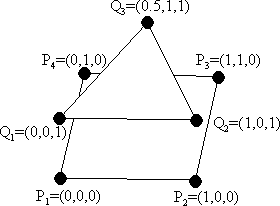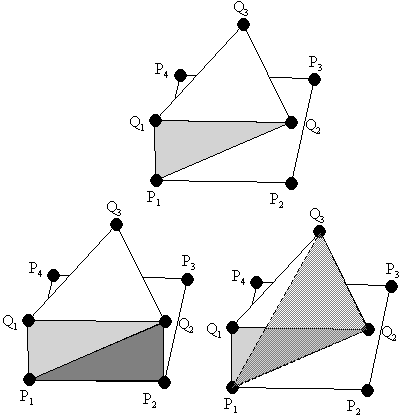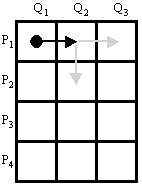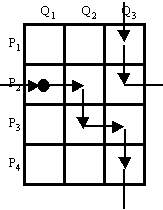Problem G
Stitching
Source code: stitch.*
Statement of the problem
 We want to reconstruct a surface from a two polygons. Think of it as if
we sliced a volume (e.g. a CAT scan (på svenska ungefär skiktröntgen))
at two z-coordinates, converted these two
planar contours into polygons, and we would now like to rebuild a surface
of the body between the polygonal cuts
from these polygons. In this problem, the resulting surface
consists of triangles only.
In the figure to the right, the objective is to "stitch" the square with
the triangle. Notice that vertices of the tile triangles which combines these
two contour polygons is vertices of the contour polygons, with the
vertices of each tile taken two from one polygon and one from the other.
We want to reconstruct a surface from a two polygons. Think of it as if
we sliced a volume (e.g. a CAT scan (på svenska ungefär skiktröntgen))
at two z-coordinates, converted these two
planar contours into polygons, and we would now like to rebuild a surface
of the body between the polygonal cuts
from these polygons. In this problem, the resulting surface
consists of triangles only.
In the figure to the right, the objective is to "stitch" the square with
the triangle. Notice that vertices of the tile triangles which combines these
two contour polygons is vertices of the contour polygons, with the
vertices of each tile taken two from one polygon and one from the other.
 Now suppose we have decided to form a triangle using
P1,Q1,Q2, shown in the upper left
picture. If the
vertices of the contour are in counterclockwise order and we are forming
triangles in counterclockwise order, we now have two options. Since the
surface built must be without "holes", P1 and Q2
must be part of the next triangle. This leaves us with either taking the
the next P-vertex, shown in the left bottom figure,
or taking the next Q-vertex,
shown in the right bottom figure.
Now suppose we have decided to form a triangle using
P1,Q1,Q2, shown in the upper left
picture. If the
vertices of the contour are in counterclockwise order and we are forming
triangles in counterclockwise order, we now have two options. Since the
surface built must be without "holes", P1 and Q2
must be part of the next triangle. This leaves us with either taking the
the next P-vertex, shown in the left bottom figure,
or taking the next Q-vertex,
shown in the right bottom figure.
Since each triangle uses one new vertex from the contour polygons,
the resulting surface will consist of 7 (4+3) triangles.
 We would like to know the minimum possible area of such a surface.
One way of solving this problem is to form a matrix. Suppose the number
of vertices of the polygons are m and n. Then build a
matrix with m rows and n columns. The position in the matrix
corresponds to the two vertices that the next, new, triangle has in
common with the last one. A movement to the right means that we are
constructing a new triangle using a new vertex from the second polygon (Q),
while a movement downwards means a new triangle using a vertex from
the first polygon (P). The movement wraps at the rightmost column and the
downmost row.
In the example, we started with the points P1 and Q1,
and used the point Q2 to from a triangle. Then we could either
pick P2 as our next point, a downward movement, or pick
Q3 as our next point, a rightward movement. Of course, the path
must end up at the starting position. For each movement, a cost is associated,
namely the area of the triangle.
We would like to know the minimum possible area of such a surface.
One way of solving this problem is to form a matrix. Suppose the number
of vertices of the polygons are m and n. Then build a
matrix with m rows and n columns. The position in the matrix
corresponds to the two vertices that the next, new, triangle has in
common with the last one. A movement to the right means that we are
constructing a new triangle using a new vertex from the second polygon (Q),
while a movement downwards means a new triangle using a vertex from
the first polygon (P). The movement wraps at the rightmost column and the
downmost row.
In the example, we started with the points P1 and Q1,
and used the point Q2 to from a triangle. Then we could either
pick P2 as our next point, a downward movement, or pick
Q3 as our next point, a rightward movement. Of course, the path
must end up at the starting position. For each movement, a cost is associated,
namely the area of the triangle.
 So, the optimization problem can be restated as the problem of finding
a closed path with the minimum sum of the costs in the matrix grid,
where each horizontal line on the grid is
crossed exactly once by the path, and where each vertical line on the grid is crossed
exactly once by the path, as in the figure to the right.
So, the optimization problem can be restated as the problem of finding
a closed path with the minimum sum of the costs in the matrix grid,
where each horizontal line on the grid is
crossed exactly once by the path, and where each vertical line on the grid is crossed
exactly once by the path, as in the figure to the right.
Hint. One simple formula to calculate the area of a triangle is Heron's
formula:  , where a, b and c
are the lengths of the sides, and p is the semiperimeter
(a+b+c)/2.
, where a, b and c
are the lengths of the sides, and p is the semiperimeter
(a+b+c)/2.
Input
The input starts with a single number on a line, N, which stands
for the number of test cases. Following this line are the N
test cases. Each test case starts with three numbers m, n,
z1. m and n are integers, greater than
2 but less than or equal to 20. m stands for the number of points in
the first polygon and n stands for the number of points in the
second polygon. z1 is a real positive number which
stands for the z-coordinates for the vertices in the second polygon.
The z-coordinates for the vertices in the first polygon is zero.
Following this line are m+n lines with x- and
y-coordinates of the
simple, not necessarily convex, polygons in counterclockwise order.
All coordinates are real numbers.
First
are the coordinates for the first polygon, followed by the coordinates
for the second polygon.
Output
For each test case, output the minimum area of the surface connecting the
both polygons, using five decimal digits. However, trailing zeros may
be omitted.
The output is a real number. A relative error of up to 0.01% is allowed.
Example
Input: Output:
2 3.72474
4 3 1 8.00000
0 0
1 0
1 1
0 1
0 0
1 0
0.5 1
4 4 2
0 0
1 0
1 1
0 1
0 0
1 0
1 1
0 1
 We want to reconstruct a surface from a two polygons. Think of it as if
we sliced a volume (e.g. a CAT scan (på svenska ungefär skiktröntgen))
at two z-coordinates, converted these two
planar contours into polygons, and we would now like to rebuild a surface
of the body between the polygonal cuts
from these polygons. In this problem, the resulting surface
consists of triangles only.
In the figure to the right, the objective is to "stitch" the square with
the triangle. Notice that vertices of the tile triangles which combines these
two contour polygons is vertices of the contour polygons, with the
vertices of each tile taken two from one polygon and one from the other.
We want to reconstruct a surface from a two polygons. Think of it as if
we sliced a volume (e.g. a CAT scan (på svenska ungefär skiktröntgen))
at two z-coordinates, converted these two
planar contours into polygons, and we would now like to rebuild a surface
of the body between the polygonal cuts
from these polygons. In this problem, the resulting surface
consists of triangles only.
In the figure to the right, the objective is to "stitch" the square with
the triangle. Notice that vertices of the tile triangles which combines these
two contour polygons is vertices of the contour polygons, with the
vertices of each tile taken two from one polygon and one from the other.
 Now suppose we have decided to form a triangle using
P1,Q1,Q2, shown in the upper left
picture. If the
vertices of the contour are in counterclockwise order and we are forming
triangles in counterclockwise order, we now have two options. Since the
surface built must be without "holes", P1 and Q2
must be part of the next triangle. This leaves us with either taking the
the next P-vertex, shown in the left bottom figure,
or taking the next Q-vertex,
shown in the right bottom figure.
Now suppose we have decided to form a triangle using
P1,Q1,Q2, shown in the upper left
picture. If the
vertices of the contour are in counterclockwise order and we are forming
triangles in counterclockwise order, we now have two options. Since the
surface built must be without "holes", P1 and Q2
must be part of the next triangle. This leaves us with either taking the
the next P-vertex, shown in the left bottom figure,
or taking the next Q-vertex,
shown in the right bottom figure.
 We would like to know the minimum possible area of such a surface.
One way of solving this problem is to form a matrix. Suppose the number
of vertices of the polygons are m and n. Then build a
matrix with m rows and n columns. The position in the matrix
corresponds to the two vertices that the next, new, triangle has in
common with the last one. A movement to the right means that we are
constructing a new triangle using a new vertex from the second polygon (Q),
while a movement downwards means a new triangle using a vertex from
the first polygon (P). The movement wraps at the rightmost column and the
downmost row.
In the example, we started with the points P1 and Q1,
and used the point Q2 to from a triangle. Then we could either
pick P2 as our next point, a downward movement, or pick
Q3 as our next point, a rightward movement. Of course, the path
must end up at the starting position. For each movement, a cost is associated,
namely the area of the triangle.
We would like to know the minimum possible area of such a surface.
One way of solving this problem is to form a matrix. Suppose the number
of vertices of the polygons are m and n. Then build a
matrix with m rows and n columns. The position in the matrix
corresponds to the two vertices that the next, new, triangle has in
common with the last one. A movement to the right means that we are
constructing a new triangle using a new vertex from the second polygon (Q),
while a movement downwards means a new triangle using a vertex from
the first polygon (P). The movement wraps at the rightmost column and the
downmost row.
In the example, we started with the points P1 and Q1,
and used the point Q2 to from a triangle. Then we could either
pick P2 as our next point, a downward movement, or pick
Q3 as our next point, a rightward movement. Of course, the path
must end up at the starting position. For each movement, a cost is associated,
namely the area of the triangle.
 So, the optimization problem can be restated as the problem of finding
a closed path with the minimum sum of the costs in the matrix grid,
where each horizontal line on the grid is
crossed exactly once by the path, and where each vertical line on the grid is crossed
exactly once by the path, as in the figure to the right.
So, the optimization problem can be restated as the problem of finding
a closed path with the minimum sum of the costs in the matrix grid,
where each horizontal line on the grid is
crossed exactly once by the path, and where each vertical line on the grid is crossed
exactly once by the path, as in the figure to the right.
 , where a, b and c
are the lengths of the sides, and p is the semiperimeter
(a+b+c)/2.
, where a, b and c
are the lengths of the sides, and p is the semiperimeter
(a+b+c)/2.